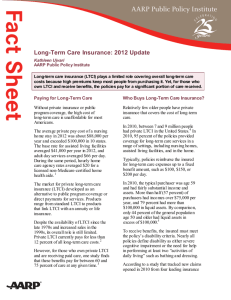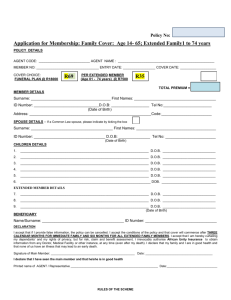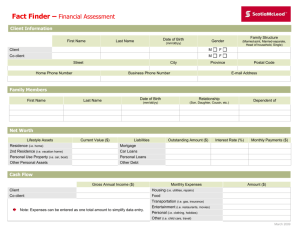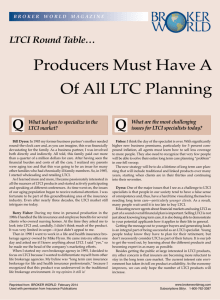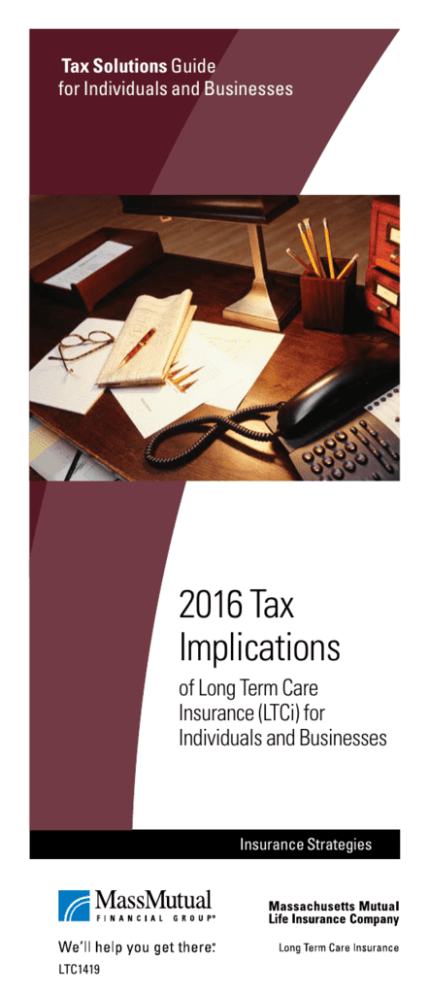
Tax Solutions Guide
for Individuals and Businesses
2016 Tax
Implications
of Long Term Care
Insurance (LTCi) for
Individuals and Businesses
Insurance Strategies
LTC1419
What are the Tax Implications
of LTCi for Individuals
and Businesses?
Individual
Premiums paid by an individual for qualified LTCi
are treated as a medical expense for purposes of
itemizing medical expenses. The amount that can be
used in calculating the expense deduction is limited
to the lesser of actual premium paid, or “eligible
long term care premium,” defined as follows:
Attained Age Before
Close of 2016 Taxable Year:
Age 40 or less:
$390
More than 40 but not
more than 50:
$730
More than 50 but not
more than 60:
$1,460
More than 60 but not
more than 70:
$3,900
More than 70:
$4,870
The amount of premium paid for the coverage of the
individual, spouse and dependents may be deducted
to the extent that total medical expenses, including
the eligible long term care premium, exceeds 10%1
of adjusted gross income (AGI).
Benefits paid on a qualified LTCi policy to an
individual are not taxable income as long as benefit
payments above $340 per day do not exceed the
actual cost of care.
7.5% of AGI for tax years ending before January 1, 2017
if the taxpayer or the taxpayer’s spouse has attained age
65 before the close of the tax year.
1
1
Sole Proprietor
Sole proprietors can deduct the full premium paid
for LTCi coverage they provide their employees.
With respect to their own coverage, the sole
proprietor can deduct 100% of the eligible long
term care premiums. “Eligible long term care
premium” is defined in the table above. There is no
10% of AGI threshold requirement.
A sole proprietor can deduct the full premium
paid for LTCi coverage if his/her spouse is an
employee and he/she provides family coverage
for the employee-spouse. The employer-spouse
is then covered by the plan as a member of the
employee’s family. If the employee-spouse is a
bona fide employee, the cost of the coverage is fully
deductible by the employer-spouse and excludable
from the employee-spouse’s gross income.
2
Partnership
When a partnership pays for LTCi coverage on its
partners, it can deduct premiums that qualify as
“guaranteed” payments under the Internal Revenue
Code (IRC) Section 707(c). LTCi premiums
constitute guaranteed payments if they are paid
for services rendered by the insureds in their
capacity as partners, without regard to partnership
income. Since partners are not employees, they
cannot use IRC Section 106(a) to exclude from
their gross income the LTCi premiums paid by
the partnership. Although partners must include
the full amount of such premiums in their gross
income, they can deduct a portion of the premiums
paid. The same rules that limit the deduction a sole
proprietor can take for his or her long term care
premiums also limit the premiums that a partner
can deduct. Members in a limited liability company
(LLC) taxed as a partnership are subject to these
same limitations.
If a spouse is a bona fide employee of a partnership
or LLC, the same rules regarding deductibility and
exclusion from gross income that are described in
the section on Sole Proprietor apply.
3
S Corporation
For fringe benefit purposes, a 2% shareholder
of an S corporation is treated like a partner in a
partnership. Therefore, an S corporation can deduct
the LTCi premiums it pays in consideration for
services rendered by the insured shareholder, and
the shareholder must include the full premium in
his or her gross income. As with sole proprietors
and partners, a 2% shareholder in an S corporation
can deduct only a limited portion of the LTCi
premiums. A 2% shareholder is defined in IRC
Section 1372 as “…any person who owns (or
is considered as owning within the meaning of
Section 318) on any day during the taxable year of
the S corporation more than 2% of the outstanding
stock of such corporation or stock possessing more
than 2% of the total combined voting power of
all stock of such corporation.” IRC Section 318
provides rules for the constructive ownership of
stock (the attribution rules). Under these rules, an
individual is deemed (i.e., considered) to own stock
owned directly or indirectly by his parents, spouse,
children and grandchildren.
4
C Corporation
Employer provided long term care insurance
qualifies as an accident and health plan within the
meaning of IRC Sections 105(b) and 106.
Employer Deduction – LTCi Premiums
When an employer pays the premium for qualified
long term care coverage for its employees, the
employer should be able to deduct those premiums
as an ordinary and necessary business expense to
the same extent that it can deduct premiums paid
for other accident and health insurance covering
its employees (IRC Section 162). However, an
employer cannot provide long term care coverage as
part of a cafeteria plan (IRC Section 125(f)).
Employee Income – LTCi Premiums
Under IRC Section 106(a), an employee does not
have to include in gross income the cost of any
employer-provided coverage under an accident or
health plan. Consequently, with one exception,
premiums paid by an employer for an employee’s
qualified long term care insurance are not
includable in the employee’s gross income. If
employer-paid premiums for qualified long term
care coverage are not included in the employee’s
gross income, then the employee cannot take an
income tax deduction for those premiums.
However, if an employer provides long term care
coverage through a flexible spending arrangement,
the employee must include the cost of that coverage
in gross income (IRC Section 106(c)). Accordingly,
the employee’s medical expense deduction is then
5
limited to the lesser of actual premium paid or the
eligible long term care premium, and the normal
threshold of 10%1 of AGI applies.
Employee Income – LTCi Benefits
The general rule is that any benefit received by an
employee through accident or health insurance
for personal injuries or sickness is included in the
employee’s gross income if the employer paid for
the coverage and the employer-paid premiums were
not included in the employee’s income when paid
(IRC Section 105(a)). This general rule does not
apply to amounts paid to reimburse the employee,
directly or indirectly, for medical care expenses
incurred by the employee, the employee’s spouse
or the employee’s dependent (IRC Section 105(b)).
Amounts received under a qualified long term care
insurance contract are treated as reimbursements for
expenses actually incurred for medical care (IRC
Section 7702B(a)(2)). As a result, if an employer
pays the premium for an employee’s qualified
long term care coverage, the employee will NOT
be taxed on the long term care benefits paid under
the insurance – those benefits are treated as a
non-taxable reimbursement for medical care. The
result is the same whether the insurance reimburses
actual long term care expenses or pays a per diem
amount toward long term care. However, if the
insurance pays a per diem benefit that exceeds
the per diem limit provided under IRC Section
7702B(d) ($340 in 2016), the excess is taxable
7.5% of AGI for tax years ending before January 1, 2017
if the taxpayer or the taxpayer’s spouse has attained age
65 before the close of the tax year.
1
6
income to the employee unless the employee’s
actual long term care expenses equal or exceed the
per diem benefit paid.
Shareholder Employees
LTCi premiums paid by a C corporation on behalf
of any shareholder are treated as non-deductible
dividends, unless the corporation can establish that
it is providing coverage to the insured in his or her
capacity as an employee. When LTCi coverage
is provided only to shareholder-employees,
the corporation must demonstrate that there
is a reasonable basis, other than their status as
shareholders, to separate the insured individuals
from non-shareholder employees who do not
receive coverage. If a corporation cannot deduct
LTCi premiums – because the premiums are treated
as a dividend to a shareholder – the insured must
include the entire premium in gross income. Again,
IRC Section 106(a) only allows employees to
exclude from gross income the cost of employerprovided LTCi coverage. If a corporation can
establish that coverage is being provided to the
insured in his or her capacity as an employee, the
same rules will apply as for coverage provided to
other employees – i.e. the corporation can deduct
the premium and the premiums will not be taxable
income to the shareholder-employee.
7
Health Savings Account (HSA)
Expenses for long term care services and premium
payments for a qualified long term care insurance
policy (subject to the eligible long term care
premium limits) are considered to be “qualified
medical expenses” as defined in IRC Section 223,
which establishes the rules for Health Savings
Accounts (HSA). As such, money in an HSA can
be used to pay these types of expenses. An HSA is
an account that you can put money into to save for
future medical expenses.
To be eligible to open an HSA, a person must have
coverage under an HSA-qualified high deductible
health plan (HDHP), have no other first-dollar
medical coverage, not be enrolled in Medicare,
and not a dependent on someone else’s tax return.
Contribution levels are determined by the effective
date of the HDHP coverage. Money in the account
can be used to pay for medical expenses for
yourself, your spouse, or your dependent children.
The information provided is not written or intended as tax
or legal advice and may not be relied on for purposes of
avoiding any Federal tax penalties. MassMutual, its
employees and representatives are not authorized to give
tax or legal advice. Individuals are encouraged to seek
advice from their own tax or legal counsel.
Long Term Care Insurance Policies issued by Massachusetts
Mutual Life Insurance Company, Springfield, MA 01111-0001.
© 2015 Massachusetts Mutual Life Insurance Company, Springfield, MA 01111-0001.
All rights reserved. www.massmutual.com. MassMutual Financial Group is a marketing
name for Massachusetts Mutual Life Insurance Company (MassMutual) and its
affiliated companies and sales representatives.
1115
CRN201612-178213


